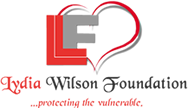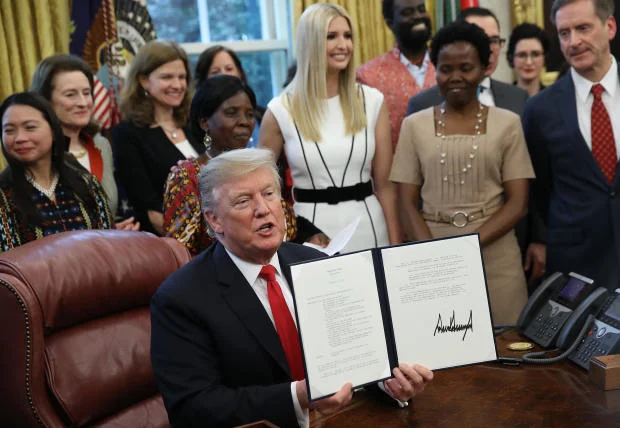President Trump and Elon Musk’s attempt to gut the decades-old USAID agency is likely to end millions of dollars in U.S. funding earmarked for women’s economic empowerment across the globe, including programs championed during Mr. Trump’s first term by his daughter Ivanka.
While Mr. Trump’s bid to put virtually all of the agency’s workers on leave is currently tied up in a U.S. court battle, the pause ordered by Secretary of State Marco Rubio at the end of January on all new U.S. foreign assistance programs funded by the State Department and USAID remains in place.
The Women’s Global Development and Prosperity Initiative was intended to help 50 million women “realize their economic potential” by 2025, an issue the president’s daughter called at the time a crucial area in which Republicans and Democrats could find common ground.
President Trump Signs Memorandum Launching The “Women’s Global Development And Prosperity” Initiative
President Trump displays a signed National Security Presidential Memorandum in the Oval Office, Feb. 7, 2019 in Washington. With the memorandum, Mr. Trump launched the Women’s Global Development and Prosperity Initiative, led by his daughter Ivanka Trump, seen behind the president, standing next to Lillian Achom (2nd from left), a projects manager for AFCHIX, a network for women in technology.
Win McNamee/Getty
Lillian Achom was a projects manager for AFCHIX, a network for women in technology, that was part of USAID’s Women Connect Challenge. In 2019, she was invited to the White House to meet Ivanka Trump, who was then an advisor to her father, and to attend the W-GDP announcement.
To coincide with the launch, Ivanka Trump wrote a Wall Street Journal op-ed in which she said W-GDP would, “for the first time coordinate America’s commitment to one of the most undervalued resources in the developing world — the talent, ambition and genius of women.”
Achom was one of nine grantees who were invited to the White House, where President Trump signed the memorandum in the Oval House on February 7, 2019. Mr. Trump’s administration pledged $50 million to W-GDP — to be allocated by USAID.
Workers say Trump’s aid freeze could cost even more lives in war-torn Sudan
Achom told CBS News on Monday that while the president had made supportive comments about the initiative, Ivanka “was somebody who really cared,” saying the president’s daughter seemed genuinely concerned about women’s development and economic empowerment.
“I could see that she really loves stories of our success, stories of how women are impacting communities around the globe,” Achom said.
The first Trump administration later said the program had reached 12 million women in its first year. The Biden administration continued W-GDP’s work under the Gender Equity and Equality Action Fund, which invested $300 million in direct resources and another $200 million in indirect funding between 2021 and 2023, according to USAID documents provided to CBS News.
Ivanka Trump did not immediately reply to a CBS News request for comment on the program or the USAID funding cuts.
A State Department spokesperson, asked about the W-GDP program, noted to CBS News Rubio’s review of foreign assistance programs, “to ensure they are efficient and consistent with U.S. foreign policy under the America First agenda.”
The spokesperson said the department was “judiciously reviewing all the waivers submitted” by various programs and personnel in a bid to keep aid flowing, and they said the results would be communicated “transparently.”
One of the focuses of the W-GDP program was women’s access to technology, which still lags behind that of men globally. According to White House documents from the time, more than 1.7 billion women in low and middle-income countries did not own a mobile phone, and they were far less likely to use mobile internet.
Rural communities in Africa have been less able to access new and emerging technologies, Achom explained, because of the cost of the internet and devices, but also because for many people, medical bills, education, and food remain the priorities.
In northern Uganda, where the prevalence of HIV among women and children has historically been higher than in other parts of the country, additional USAID funding provided through the aid relief program, PEPFAR, gave communities access to ongoing supplies of antiretroviral drugs. Such support is limited from Uganda’s own government because of its restrained finances, Achom said.
“USAID has really treated those in the community like their friend,” she said. “Like their number one friend, I should say, because they’ve visited them, they’ve given them grants, not only to support them with medical facilities and access to medicine, but to access economic empowerment.”
USAID funding was also consistent and reliable, unlike some other programs, and shutting down agency-funded programs, Achom said, will affect more than just women’s access to technology.
“The ability of the entire community to move out of poverty is really going to be slowed down or compromised,” she told CBS News.

